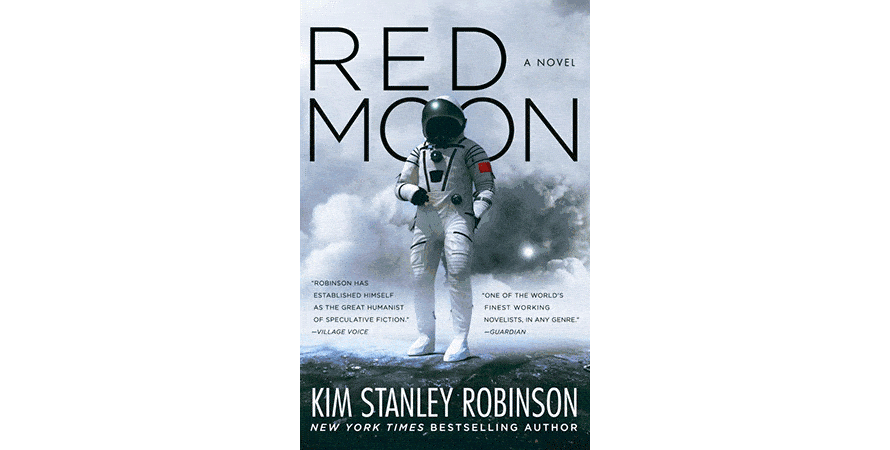Category: Fiction
Reviewed by Peter Spasov
Title: Red Moon
Author: Kim Stanley Robinson
NSS Amazon link for this book
Format: Hardcover, Kindle, audiobook
Pages: 464
Publisher: Orbit
Date: October 2018
Retail Price: $27.00/13.99
ISBN: 978-0316262378
From a lunar landing via reverse rail gun to dodging a missile in a rover— plus everything else in between, Red Moon is both heady adventure and thinking philosophy. This is a book about the technology of space settlement, earthly politics and human culture. Finally it portrays a future for everyone.
When Fred Frederickson arrives to deliver a quantum communications device, he soon finds himself embroiled in a war of factions among the Chinese. Along the way he befriends Ta Shu, a travel blogger and finds himself entangled with a symbol of resistance, a mystery woman with influence, Chang Qi.
The adventure highlights a crisis of representation in American democracy and Chinese communism. Add espionage, cyber warfare, IP theft, kidnapping, infighting and the first ever lunar pregnancy. Suspense builds; eventually we learn who Qi is. There are dicey situations such as Qi’s water breaking while in a spacesuit followed by a birth inside an emergency solar storm shelter. Then Qi and Fred escape with motorized trikes by placing the newborn inside an adult spacesuit using a clever innovation.
During 2047 the waidiren (outsiders) remain excluded from upward economic mobility due to hukou, a household registration system. Chang Qi becomes a lightning rod for this dissatisfaction. Ta Shu has connections to political leadership who may be a reformer or not. Meanwhile Fred Fredericks is caught inside the turmoil. An analogous conflict simultaneously erupts in America when a significant population triggers a financial crisis due to non-confidance. These events come to a head in a climax, hinting at a profound change, the beginning of true democracy.
The novel mixes hard science and mysticism. Fred muses on the pilot wave interpretation of quantum mechanics. In one section Shu describes early history of the solar system, which also foreshadows events yet to unfold. He practices Feng shui, literally ‘wind-water,’ a pseudoscience about harmonizing with energy forces and refers to Kepler and Galileo as feng shui masters. Meanwhile, Fred wonders if it could be an ancient folkloric intuition of quantum mechanics. Indeed, the author uses the language of quantum physics several times throughout the story.
Robinson also gives a lot of thought to lunar infrastructure, including the use of lava tubes. Because lunar settlers need to harvest carbon, they use mass drivers to place carbonaceous chondrite asteroids into lunar orbit, and then crash them onto the surface. In one case, this happens during a solar eclipse where the dust will cause a red annular band to appear around the Earth, hence the title of the book. Robinson adds more color when a character compares the eerie scenery to an opera performance of Parsifal.
As Ta Shu narrates, China builds significant infrastructure on the Moon because it has always built grand structures such as the Great Wall and Grand Canal. “Money needs to be sent to become wealth,” he says. Finance includes virtual US dollars and carboncoins, a cryptocurrency validated by taking carbon out of the air. One can only buy sustainable subsistence necessities with it. There is blockchain governance where every legal action is recorded and secured step by step, or “documented anarchy” as one character states it.
In typical Robinson style, there are artistic elements and references throughout the work. Passages are visually descriptive. Segments of classical poetry appear throughout. Chapter titles are in English and Pinyin. He is a master at describing setting; lunar landscapes are a contrast of light and dark, a gray-on-black world where gravity causes one to move in fluid ways, sometimes elegant, or clumsy, depending on the context. Other places, in contrast, have pulsating colors. His description of Shackleton crater is typical of the author as art connoisseur. A marketplace on Earth is like a painting with ancient willow trees which then morphs into a scene of hustle and bustle and from there to musicians playing sounds alien to western ears. Robinson coins words such as “adhocitecture,” and uses quantum language such as “the two emotions superposed and could not be disentangled.” Generally the writing is serious, but sprinkled with occasional irreverence and word play. Other sections use the perspective of AI research. All of these provide helpful background for the reader.
The author has published many works typically in the genre of humanist science fiction and is best known for his Mars Trilogy. Red Moon could be Robinson’s most thoughtful yet entertaining novel to date, one in which he has obviously familiarized himself with many aspects of Chinese culture and history.
This is a book well worth reading because it is a sensory novel delivering the experience of the alien, both of China for westerners and the lunar environment. He has always been an eclectically intelligent writer.
© 2018 Peter Spasov
Please use the NSS Amazon Link for all your book and other purchases. It helps NSS and does not cost you a cent! Bookmark this link for ALL your Amazon shopping!



















